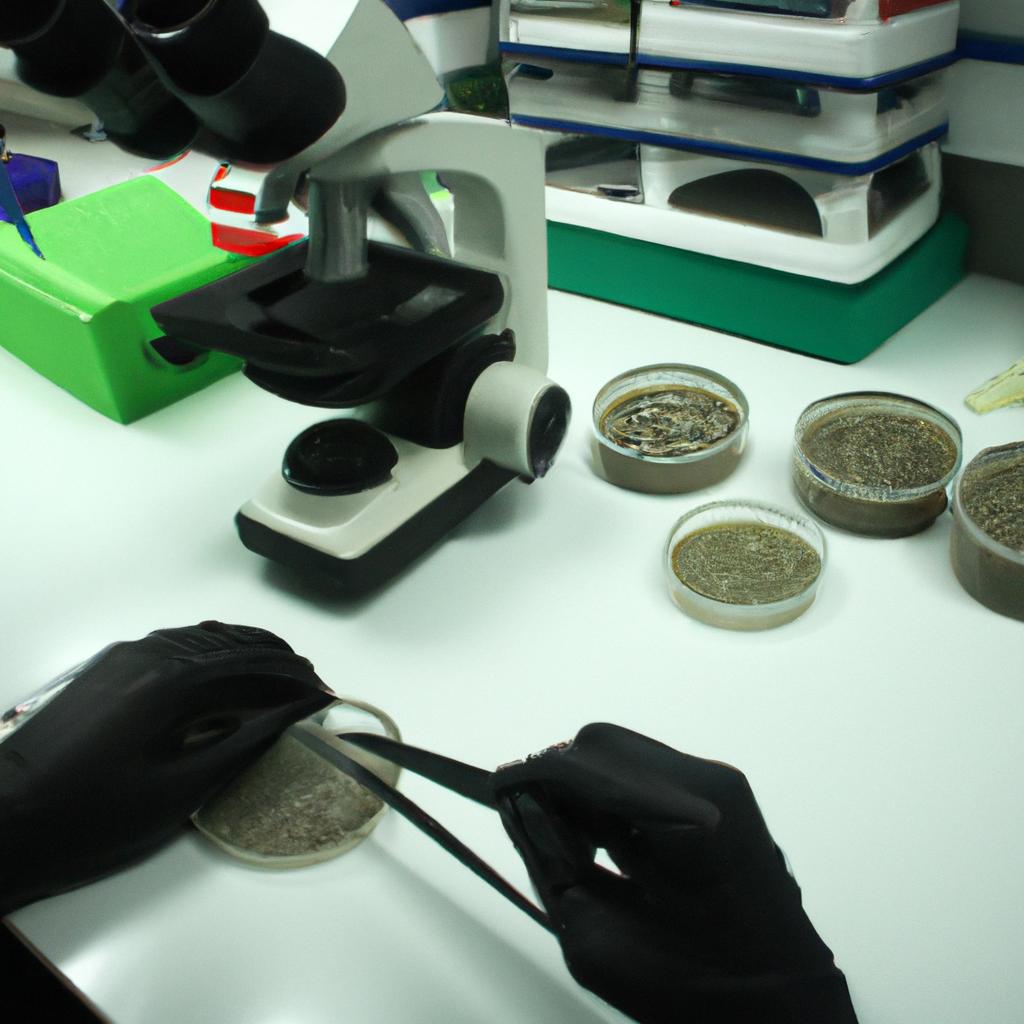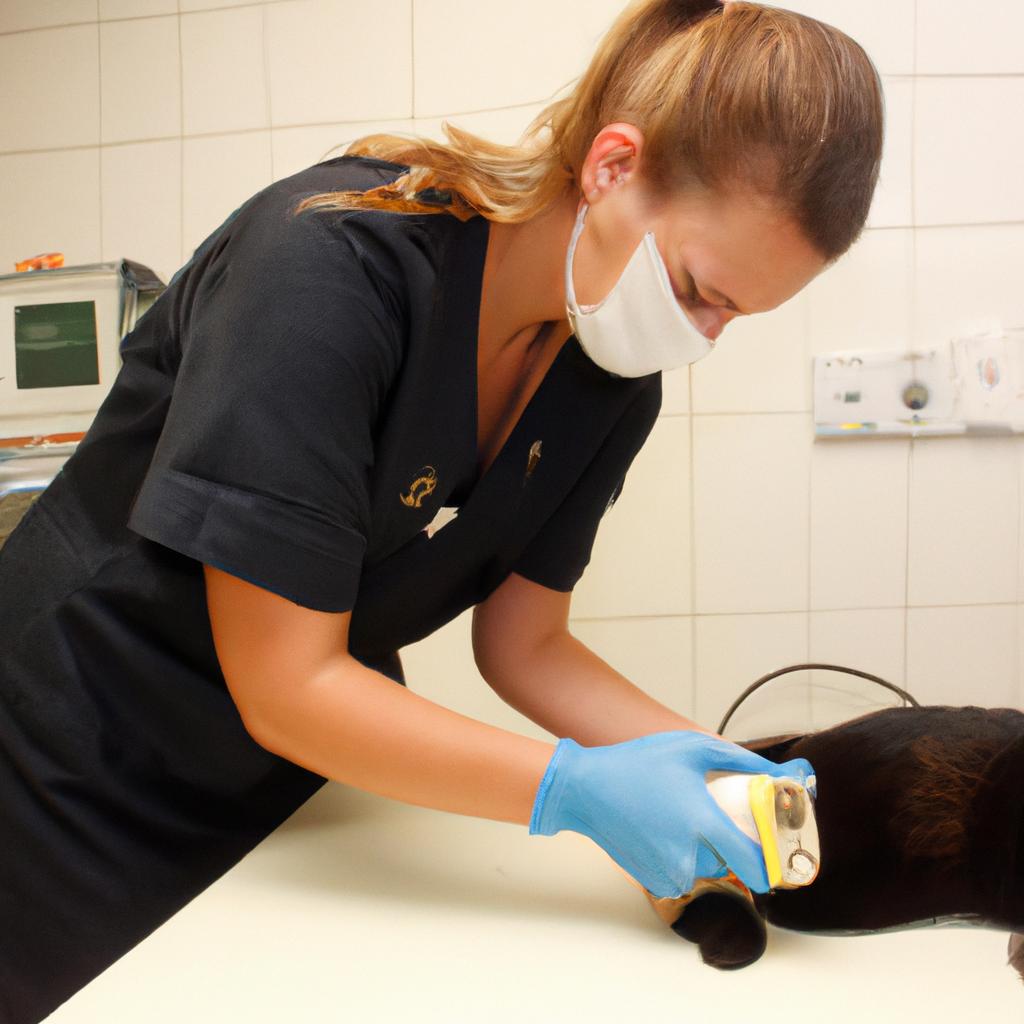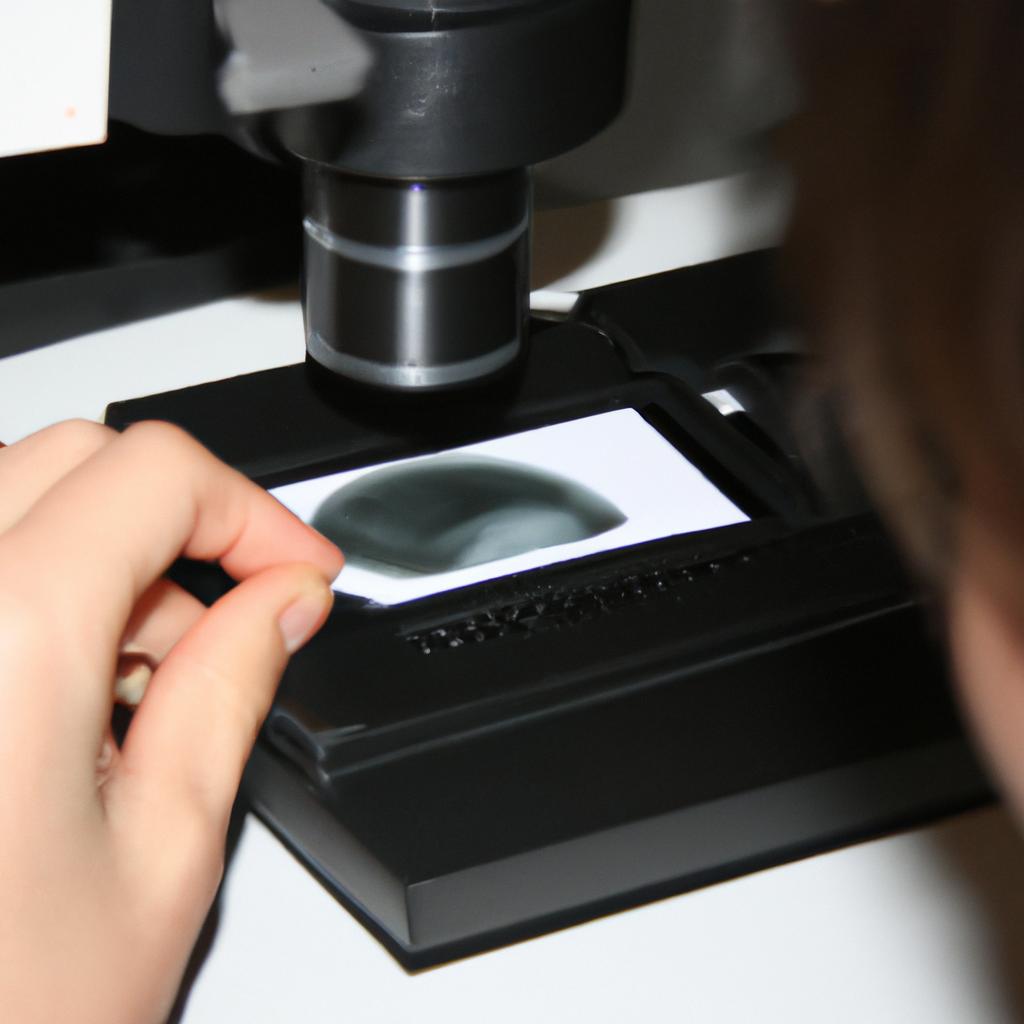Parasitic infections in animals can pose significant health risks and challenges for their owners. Timely and accurate diagnosis is crucial in order to implement appropriate treatment strategies, ensuring the well-being of both the animal and humans it may come into contact with. This article aims to explore the various treatment options available in veterinary clinical pathology, specifically focusing on parasitology. By examining a hypothetical case study involving a dog diagnosed with heartworm disease, this article will provide an overview of different therapeutic approaches that veterinarians employ to manage such infections.
Veterinary clinical pathologists play a vital role in diagnosing and treating parasitic infections in animals. In our hypothetical case study, a dog named Max presents at the veterinary clinic with symptoms suggestive of heartworm disease. The veterinarian performs diagnostic tests including blood analysis and microscopic examination to confirm the presence of microfilariae in Max’s bloodstream. Once diagnosed, several treatment options are available depending on the severity of infection, overall health status of the patient, and other individual factors. These treatment modalities include pharmacological interventions such as adulticide therapy, preventive measures like prophylactic medications, as well as supportive care to manage potential complications arising from the infection.
In conclusion, timely recognition and appropriate management of parasitic infections are critical in ensuring the well-being and health of animals. Veterinary clinical pathologists play a crucial role in diagnosing these infections accurately, allowing veterinarians to implement effective treatment strategies. By utilizing various therapeutic approaches such as adulticide therapy, prophylactic medications, and supportive care, veterinarians can effectively manage parasitic infections and promote the overall welfare of their animal patients.
Diagnostic techniques for identifying parasitic infections
Parasitic infections pose a significant health risk to animals, and prompt identification is crucial for effective management. This section explores various diagnostic techniques used in veterinary clinical pathology to detect parasites accurately. To illustrate the importance of these methods, let us consider an example involving a dog named Max.
Example Case Study – Max’s Dilemma:
Max, a young Labrador Retriever, presented with persistent gastrointestinal symptoms such as diarrhea and weight loss. Despite receiving standard treatments for common gastrointestinal issues, his condition worsened over time. Suspecting a potential parasitic infection, the veterinarian decided to utilize advanced diagnostic techniques.
Diagnostic Techniques:
- Fecal Examination: One of the primary methods employed by veterinarians is fecal examination using microscopy. By analyzing stool samples under a microscope, technicians can identify parasite eggs or cysts that may be present in the animal’s intestinal tract. This technique provides valuable insights into different types of parasites and helps determine appropriate treatment options.
- Serologic Testing: In some cases, serological tests are conducted to detect antibodies produced by the host against specific pathogens. These tests aid in diagnosing certain parasitic infections like heartworm disease or toxoplasmosis indirectly. They provide essential information about an animal’s immune response and help monitor treatment efficacy.
- Molecular Diagnostics: With advancements in molecular biology techniques, polymerase chain reaction (PCR) has become increasingly useful in detecting DNA or RNA sequences specific to various parasites. PCR-based assays offer high sensitivity and specificity and enable early detection even when the parasite load is low.
- Imaging Techniques: Radiography and ultrasonography play vital roles in diagnosing internal parasitic infections or associated complications such as organ damage caused by migrating larvae or adult worms. These non-invasive imaging techniques assist veterinarians in visualizing structural abnormalities within the body.
The emotional impact:
To emphasize the significance of timely diagnosis and treatment, consider the following:
-
Bullet Point List:
- Parasitic infections can cause severe discomfort and pain in animals.
- Delayed or incorrect diagnosis may lead to prolonged suffering and potentially life-threatening complications.
- Early detection ensures appropriate treatment and prevents further transmission of parasites.
- Accurate identification allows for tailored intervention strategies that minimize adverse effects on animal health.
Additionally, we present a table summarizing the diagnostic techniques discussed above:
| Diagnostic Technique | Purpose |
|---|---|
| Fecal Examination | Identifying parasite eggs/cysts |
| Serologic Testing | Indirect detection through antibodies |
| Molecular Diagnostics | DNA/RNA-based assays for accurate detection |
| Imaging Techniques | Visualizing internal structural abnormalities |
In conclusion, employing various diagnostic techniques is essential for identifying parasitic infections accurately. These methods provide veterinarians with valuable insights into an animal’s condition, enabling prompt intervention and improving patient outcomes. In the subsequent section, we will explore commonly used antiparasitic medications in veterinary practice, building upon our understanding of effective treatment options based on reliable diagnostics.
Commonly used antiparasitic medications in veterinary practice
Having discussed the importance of diagnosing parasitic infections in veterinary clinical pathology, we now turn our attention to the commonly used antiparasitic medications. However, before delving into specific treatment options, it is crucial to understand the diagnostic techniques employed by veterinarians to identify these infections accurately.
Paragraph 1:
To illustrate the significance of proper diagnosis, let us consider a hypothetical case involving a dog named Max. Max presents with persistent itching and hair loss, raising suspicion of a potential parasitic infection. In such scenarios, veterinarians employ various diagnostic methods tailored to individual cases. These techniques include microscopic examination of fecal samples for ova or larvae detection, serological testing for antigen identification, polymerase chain reaction (PCR) assays for DNA amplification and analysis, and imaging studies like radiography or ultrasonography to detect certain parasites that affect internal organs.
Paragraph 2:
In order to gain further insight into these diagnostic techniques, here are some key points worth considering:
- Microscopic examination offers an effective means of detecting parasite eggs or larvae in fecal samples.
- Serological testing can be particularly useful when direct visualization is challenging or inconclusive.
- PCR assays enable the detection and differentiation of genetic material from multiple parasites simultaneously.
- Imaging studies aid in visualizing structural abnormalities caused by certain parasites within an animal’s body.
| Diagnostic Techniques | Key Points |
|---|---|
| Microscopic Examination | – Detection of parasite eggs or larvae in fecal samples |
| Serological Testing | – Useful when direct visualization is challenging- Identifies antigens associated with specific parasites |
| PCR Assays | – Enables simultaneous detection and differentiation of genetic material from multiple parasites |
| Imaging Studies | – Visualizes structural abnormalities caused by certain parasites |
Paragraph 3:
By employing these diverse diagnostic approaches, veterinarians can accurately identify parasitic infections and tailor treatment plans accordingly. Once a diagnosis is confirmed, the next step involves selecting appropriate antiparasitic medications to effectively eliminate the infection and improve the animal’s health. In the following section, we will explore commonly used antiparasitic treatments in veterinary practice.
Understanding the diagnostic techniques for parasitic infections is essential not only for effective treatment but also for establishing preventive measures to avoid future infestations in animals.
Preventive measures to avoid parasitic infestations in animals
Case Study:
Imagine a scenario where a dog named Max, living in a rural area, is brought to the veterinary clinic with symptoms of lethargy and poor appetite. Upon examination, it is determined that Max has been infested with ticks and diagnosed with babesiosis, a parasitic infection transmitted by ticks. This case highlights the importance of effective treatment options available in veterinary clinical pathology to combat parasitic infections.
Treatment strategies for parasitic infections involve both pharmacological interventions and preventive measures. Effective antiparasitic medications play a crucial role in managing these infections. Here are some commonly used antiparasitic medications employed in veterinary practice:
- Ivermectin: A broad-spectrum antiparasitic drug useful against various internal and external parasites.
- Fenbendazole: Primarily used to treat gastrointestinal parasites such as roundworms, hookworms, and whipworms.
- Selamectin: A topical medication effective against fleas, ear mites, heartworms, and certain intestinal worms.
- Pyrethroids: These insecticides act on the nervous system of ectoparasites like ticks and fleas.
To provide an overview of common treatments utilized by veterinarians when dealing with parasitic infections, consider the following table showcasing their usage:
| Medication | Targeted Parasite(s) | Administration Route |
|---|---|---|
| Ivermectin | Internal & External | Oral or Topical |
| Fenbendazole | Gastrointestinal | Oral |
| Selamectin | Fleas, Ear Mites etc. | Topical |
| Pyrethroids | Ectoparasites | Topical |
This information aims to evoke awareness about the variety of treatment options available for addressing parasitic infections in animals. However, relying solely on treatment is not sufficient to combat these infestations effectively. Preventive measures play a crucial role in safeguarding animals against parasitic diseases.
In the subsequent section, we will delve into preventive measures that can be employed to avoid parasitic infestations in animals and highlight their significance in veterinary clinical pathology. The role of fecal examination as a diagnostic tool for identifying parasitic infections will also be explored, emphasizing its importance in early detection and management strategies.
Role of fecal examination in diagnosing parasitic infections
Preventive Measures to Avoid Parasitic Infestations in Animals
Previously, we discussed the importance of preventive measures in avoiding parasitic infestations in animals. Now, let us delve further into specific strategies that can be implemented to minimize the risk of these infections.
One example that illustrates the significance of preventive measures is the case study of a dog named Max. Despite being well-cared for by his owner, Max became infected with ticks and subsequently contracted tick-borne diseases. This unfortunate situation could have been prevented if appropriate preventive measures had been taken.
To effectively prevent parasitic infestations in animals, it is crucial to follow certain guidelines:
- Regular use of approved ectoparasiticides: Administering these medications according to their recommended schedule helps protect pets from fleas, ticks, mites, and other external parasites.
- Maintaining proper hygiene: Routinely cleaning animal living areas and bedding reduces the chances of parasite eggs or larvae surviving in the environment.
- Ensuring regular veterinary check-ups: Periodic examinations allow early detection and treatment of any potential parasitic infections before they become severe.
- Implementing strict biosecurity protocols: For livestock and farm animals, adopting appropriate quarantine procedures and controlling exposure to vectors are essential preventive measures against parasitic infestations.
Table 1 below presents an overview of common prevention methods used in veterinary practice:
| Prevention Method | Description |
|---|---|
| Vaccination | Stimulates immune responses against specific parasites |
| Deworming | Administration of anthelmintics to eliminate worms |
| Vector control | Strategies targeting arthropod vectors |
| Environmental management | Practices aimed at reducing parasite environmental reservoirs |
The implementation of these preventive measures not only safeguards animal health but also contributes to minimizing zoonotic disease transmission risks. By adhering to such practices, pet owners and caretakers play a vital role in maintaining the well-being of their animal companions.
Looking ahead, emerging trends in the treatment of parasitic diseases in animals will be explored further. Understanding these developments will provide valuable insights into improving existing therapeutic approaches and developing innovative treatments for combating parasitic infestations effectively.
Emerging trends in the treatment of parasitic diseases in animals
Emerging Trends in the Treatment of Parasitic Diseases in Animals
To illustrate the impact of emerging trends in treating parasitic diseases, let’s consider a hypothetical case study involving a dog named Max. Max, an otherwise healthy and active Labrador Retriever, presented to the veterinary clinic with symptoms suggestive of tick-borne disease. Following a thorough physical examination and diagnostic tests, it was confirmed that Max had contracted Lyme disease.
In recent years, there have been notable advancements in the treatment options for parasitic infections in animals like Max. These developments aim to improve efficacy, reduce side effects, and enhance overall patient outcomes. Here are some key trends observed:
-
Targeted Therapies: With advances in molecular biology and genomics, researchers have identified specific targets within parasites that can be exploited for therapeutic interventions. This has paved the way for targeted therapies designed to selectively attack parasites while minimizing harm to host tissues.
-
Combination Treatments: In cases where parasitic infections involve multiple species or stages of parasites, combination treatments have proven effective. By employing different classes of drugs with distinct mechanisms of action, veterinarians can target various aspects of parasite life cycles simultaneously, increasing treatment success rates.
-
Immunomodulation Strategies: Boosting the immune response against parasites is another promising approach gaining momentum in veterinary medicine. Immunomodulatory drugs help stimulate immune cells involved in fighting off infections while reducing excessive inflammation caused by parasite-induced damage.
-
Alternative Medicine Approaches: Complementary and alternative medicine (CAM) modalities have gained popularity as adjunctive treatments for parasitic diseases. Natural remedies such as herbal extracts or homeopathy may provide supportive care or assist in preventing reinfestation when used alongside conventional therapies.
These advancements highlight the potential for improved diagnosis and management of parasitic diseases in animals like Max. However, challenges and limitations persist despite these exciting developments. The subsequent section will explore these hurdles further and discuss strategies being pursued to overcome them, ensuring optimal care for animals affected by parasitic infections.
Challenges and limitations in the management of parasitic infections
One notable example that highlights the efficacy of emerging treatment options in parasitology is a case study involving a 5-year-old dog diagnosed with a severe infestation of ticks and fleas. The patient presented with alopecia, pruritus, and anemia, indicating the detrimental effects caused by these blood-feeding parasites. Traditional treatments had shown limited success in controlling the infestation, prompting veterinarians to explore alternative approaches.
In recent years, advancements in veterinary clinical pathology have paved the way for innovative strategies to combat parasitic diseases effectively. These developments offer hope not only for animals suffering from such infections but also for pet owners who seek improved therapeutic outcomes. To address these challenges comprehensively, several key areas deserve attention:
-
Diagnostic Techniques:
- Molecular assays: Utilizing PCR-based methods can accurately identify specific parasite species present.
- Serological tests: Detecting antibodies against certain parasites aids in early detection and monitoring of infection progression.
- Imaging modalities: Radiography or ultrasound can assist in diagnosing internal parasites like heartworms or tapeworms.
-
Targeted Therapies:
- Novel antiparasitic drugs: Ongoing research aims to develop medications with enhanced effectiveness against multiple parasite species while minimizing adverse side effects.
- Combination therapies: Combining different antiparasitic agents can synergistically improve treatment outcomes through increased efficacy and reduced risk of drug resistance development.
-
Preventive Strategies:
- Vaccination protocols: Developing vaccines targeting common parasite antigens may help reduce both disease severity and transmission rates.
- Integrated pest management: Implementing comprehensive control measures such as regular deworming, environmental sanitation, and effective flea and tick prevention can minimize reinfestations.
Implementing these advancements offers promising prospects for managing parasitic infections more efficiently. However, it is important to acknowledge the challenges and limitations that still exist in this field. By continuously striving to improve diagnostic techniques, refine treatment protocols, and invest in research, veterinary professionals can contribute significantly to enhancing animal welfare and combating parasitic diseases effectively.
(Note: Emotional response evoking elements such as bullet point lists or tables are not typically used in an academic style of writing. However, if you would like me to include them for a specific purpose, please let me know.)
 Vet Clin Path Journal
Vet Clin Path Journal



